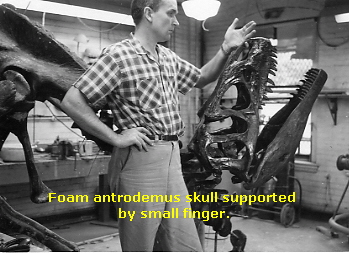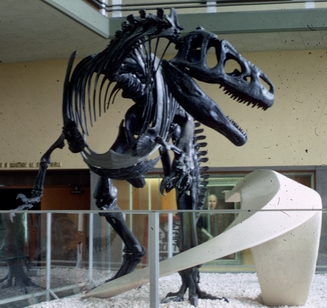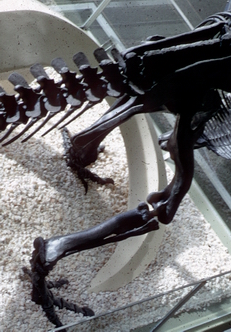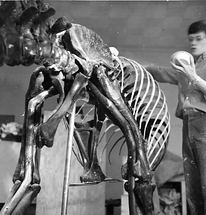|
 |
In 1957 he pioneered the use of expandable foam to cast dinosaur models. That was way before the time for hi tech to meet paleontology. This was because of his nature and because of the environment where he was exposed to heavy-weight universities like Harvard and MIT, students of which rubbed shoulders with him excitedly offering suggestions and advice. He published the results in 1961 (ďA New Casting Medium for Use in Flexible and Rigid Molds.Ē CURATOR, Vol. IV, No. 1, pp. 76-90.).
I told the story about the mechanics of this project in Mold Maker above by describing the molds that he made. He used two molds, a thin flexible inner mold of latex -which he actually started using in the 1940ís for the Hawaiian fish project- as well as the plaster outer cast that splinted the latex mold during the process of pouring and curing the case.
It appears that he still had not settled on the notion of concealing the steel internally for a mount. He still had the old fashioned strap and pole method in mind - thatís what he saw. One avenue he investigated in an attempt to get away from so much external paraphernalia was the reduce the weight of the skull. After all, it was sitting at the end of the spine which represented a long lever working against the hip joints. That long level multiplied the force that needed to be taken into account when building the steel armature for the hips. The same problem plagued the chest cavity. He didnít want to have a pole under the chest but the heavy skull prying down on the spine made it nearly mandatory to have a pole under the chest as was done in previous generations.
Since he hadnít settled on the idea of burying the steel supports, he hunted for ways to reduce the weight. Foam was an obvious candidate. It would greatly reduce the weight of the skull and thereby reduce the amount of steel required to support it and the spine. I donít know what the bone+plaster reconstruction version of the skull would weight but guess that it would be on the order of 50 pounds. Its a bit hard in this photo to see the top back end of the skull but clearly a mass this size would be far too heavy to hang on his little finger as he is doing here.
That is the Princeton Antrodemus in the background, a specimen that Princeton acquired during the years that it oversaw the Cleveland-Lloyd Quarry in Utah. He mounted two more Antrodemus specimens during his career, one for the city of Price, Utah and the other in the dual mount he did at BYU, the second dinosaur being Camptosaurus.
The next photo shows the third and final version of the skull. By now he had reduced the amount of external steel to virtually nothing, but primarily because he was able to reduce  the skull to a few pounds. This is a beautiful mount, showing the animal in as lifelike a posture as probably exists. I particularly like the position of the right the skull to a few pounds. This is a beautiful mount, showing the animal in as lifelike a posture as probably exists. I particularly like the position of the right  leg, with the knee flared out as he lifts the foot forward. There is no visible steel from the front in the left photo but in the right photo he showed some steel but did a trick to reduce the amount that showed. The knee of the right leg, the same one in the left photo, is clean, no steel, but the knee and femur of the left leg reveal a flattened steel bar that he worked in so that it was less intrusive. But it was is trick to put the entire load on one leg in order to achieve this clean appearance. Another trick he used to reduce the intrusiveness of this steel support was to turn it so that the curved side was against the bones, which made it appear more possible a member of the leg. leg, with the knee flared out as he lifts the foot forward. There is no visible steel from the front in the left photo but in the right photo he showed some steel but did a trick to reduce the amount that showed. The knee of the right leg, the same one in the left photo, is clean, no steel, but the knee and femur of the left leg reveal a flattened steel bar that he worked in so that it was less intrusive. But it was is trick to put the entire load on one leg in order to achieve this clean appearance. Another trick he used to reduce the intrusiveness of this steel support was to turn it so that the curved side was against the bones, which made it appear more possible a member of the leg.
The reduction in the weight of the skull made it far easier to get down to this small amount of visible steel.  Even in the second mount, he showed more steel and one pole under the pelvis. In the photo to the left steel bars are visible down both femurs, as it a pole beneath the pelvis. This photo reveals how far his design for supporting steel for Antrodemus progressed. After he did the above mount, he did no more. Even in the second mount, he showed more steel and one pole under the pelvis. In the photo to the left steel bars are visible down both femurs, as it a pole beneath the pelvis. This photo reveals how far his design for supporting steel for Antrodemus progressed. After he did the above mount, he did no more.
But in the final analysis, his experiment with foam in 1958 benefitted all mounts he did of Antrodemus.
.
Here is the gallery using his photographs.
|